Long-range ballistic missile P-1
The appearance of the P-1 rocket was preceded by more than interesting events related to the study of trophies and the groundwork of the destroyed enemy. During the Great Patriotic War, the Soviet command learned about the appearance of a new Germany weapons - ballistic missile A-4 / V-2. Such weapons were of great interest to the USSR and its allies, and therefore a real hunt began behind it. After the victory over Germany, the Coalition countries were able to search military enterprises and find the necessary documents, products, etc.
Search for trophies
In the last weeks of the war, in April 1945, US troops were able to seize the German Mittelwerke factory, which operated near Nordhausen. Various products were made there that were of particular importance to the German forces, including the A-4 ballistic missiles. American experts have carefully studied all the available documentation, as well as the remaining components and assemblies of various equipment. Much of the papers, products and employees were soon sent to the United States. In the summer of 1945 th Thuringia, together with the Mittelwerke plant, became part of the Soviet occupation zone, and new commissions arrived at the enterprise.
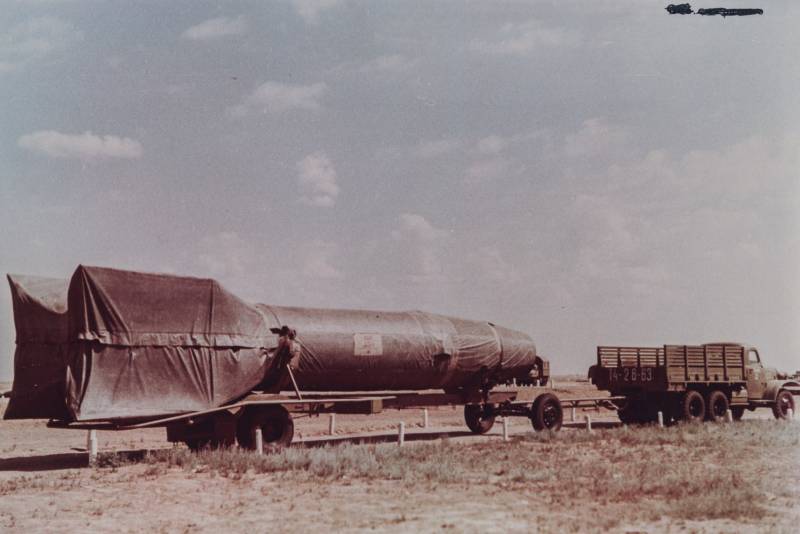
Rocket R-1 on the transport trolley. Photo of the Ministry of Defense of the Russian Federation / mil.ru
Unfortunately, the vast majority of the most interesting objects and documents by this time were removed. Nevertheless, the remaining finds could be useful for the Soviet industry. The country's leadership planned to carefully study the German developments and use them in their own projects of rocket technology. At the same time, it was obvious that the former allies had already investigated the trophies and, perhaps, would soon apply the knowledge gained in practice.
In the first months of 1946, several new organizations were formed. Thus, the Nordhausen and Berlin institutes began work in Germany. In the USSR, a new scientific research institute-88 was organized. It was also decided to repurpose some existing enterprises. In fact, it was about creating a completely new industry, which was to deal with promising weapons of strategic importance. It was assumed that the industry would use both its own experience in the field of rocket technology and German developments.
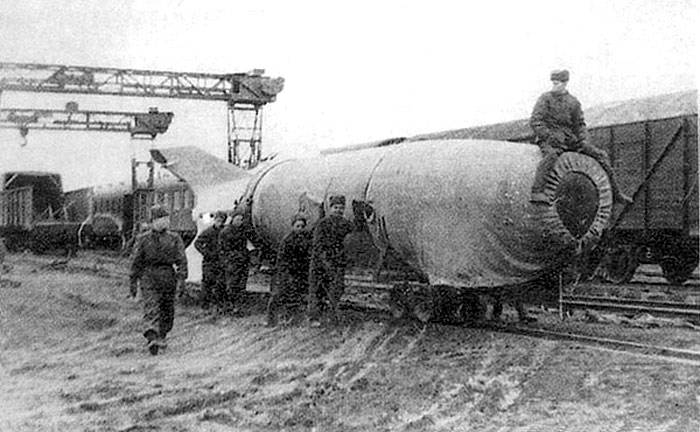
Transportation of an experimental P-1 rocket (according to other data, A-4 of the Soviet assembly). Photo RKK Energy / energia.ru
In May 1946, the USSR Council of Ministers decided to begin work on the creation of the first Russian ballistic missile. As part of this project, it was proposed to restore the technical appearance of the German A-4 rocket, as well as to master its production and assembly at German and Soviet enterprises. The newly created Scientific Research Institute-88 of the Ministry of Weapons was appointed the lead contractor for the project. The work leader was S.P. Korolev. Other organizations, both relatively old and recently created, should also have participated in the program.
Assembly and Testing
Initially, it was only about assembling missiles from finished components made in Germany. At the same time, the specialists of SRI-88 and Nordhausen had to restore the design of some components and assemblies for which there was no documentation. Assembling the first series of missiles was organized at two sites. Plant No.3 in Germany assembled A-4 missiles from available components, supplemented with new types of products. Such missiles were designated by the letter "H". The company also prepared assembly kits, which were sent to the experimental plant of the Scientific Research Institute-88 in the Moscow Region. The rockets of the "Soviet" assembly were designated as "T".
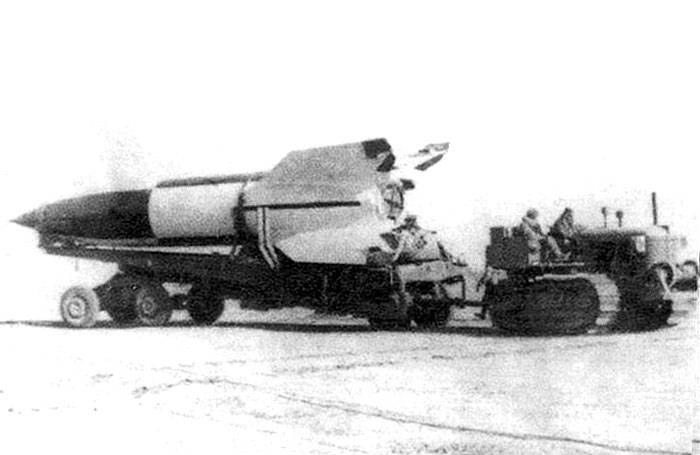
In the process of delivering the rocket to the launch pad. Photo RKK Energy / energia.ru
According to known data, in the framework of the first batch, 29 H and 10 missiles of T products were made. The first H-type missiles were transported from Germany to the Soviet Union in the spring of 1947. Together with weapons in the USSR sent launchers, control equipment, etc. A few months later, rockets with “T” letters were prepared for testing. Testing and test launches were entrusted to a specially formed Special Purpose Brigade of the Reserve of the High Command (BON RVGK).
October 16 The first fire tests of one of the new missiles took place at the Kapustin Yar range near Stalingrad. The systems worked normally, and BON RVGK received permission to carry out a full launch. October 1947 rocket with a serial number 18T made the first flight on a regular trajectory. Flight range was 10 km. Deviation from the calculated point of impact - 206,7 km to the left. Two days later they launched a rocket 30T, flying 04 km. However, even on the active site, it deviated from the given trajectory and fell in 231,4 km from its target.
The next week was a period of difficulties and accidents. The 08T, 11T and 09T rockets did not want to turn on the engines and start. October 25 after refueling the product 09T on the launch pad there was a breakdown of the launcher. During the discharge of fuel and oxidant liquid oxygen got into the engine. Fortunately, all these accidents have done without victims and destruction.
Soon the specialists managed to adjust the work of all the systems, and by the end of October two new missiles flew. 2 November launched A-4 with scientific equipment on board. However, the accident happened the next day. The rocket 30H after the start began to rotate around the longitudinal axis, then caught fire and fell several kilometers from the launch position. However, this did not prevent the testing. Up to November 13, four more launches took place without emergency situations and accidents. In the last launch, the rocket for the first time used inertial guidance with a correction in two radio beams.
Almost in a month of the first stage of testing, 11 launches of A-4 / V-2 missiles took place, and almost all of them ended in success or without serious difficulties. In general, the tests were not without problems, but the main difficulties arose before the start, and they were able to cope with them. The success of the first series of test launches allowed to continue the work and create new versions of rocket weapons.
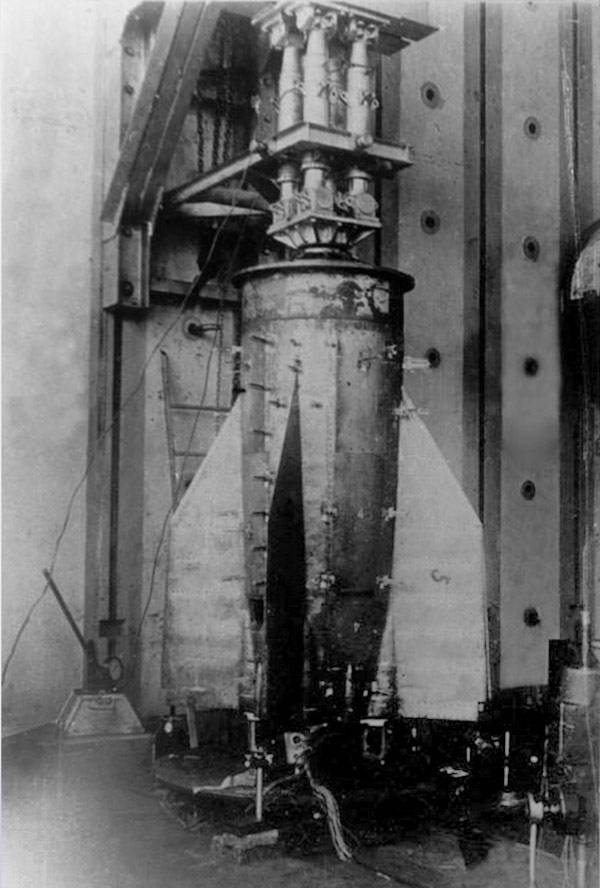
The tail section of the rocket on static tests. Photo TsNIIMASH / tsniimash.ru
Project "Victory"
14 April 1948, the USSR Council of Ministers decided to start developing a new version of the existing A-4 rocket. The existing design should be improved to enhance the basic characteristics. In addition, now the rocket had to be fully produced in the enterprises of the Soviet Union. The finished missile system after all the necessary tests had to go to the arsenal of the Soviet army. The domestic development missile received the designation P-1, as well as the name "Victory". After adopting it, she was assigned the index 8А11.
Employees of SRI-88 faced a number of challenges. Exact copying of the finished A-4 rocket was not possible for technological reasons, and besides, it did not make sense. The German project involved the manufacture of parts made of steel 86 grades, 56 grades of non-ferrous metals and 87 non-metallic materials. Soviet engineers and technologists were able to find a replacement for the missing alloys. The P-1 project used 32 substitute steel grades, 21 new non-ferrous metal and 48 non-metallic materials. Also, the instrument and tail compartments of the rocket were processed and improved.
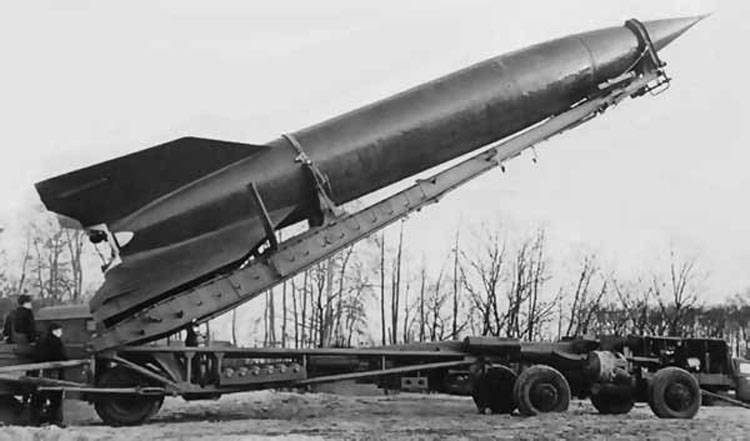
Rocket P-1 in preparation for launch. Photo Dogswar.ru
The main design features of the P-1 rocket were transferred to the new project from the existing one. Still used single-stage architecture with built-in fuel and oxidizer tanks. On the basis of the German product, a liquid engine RD-100 / 8Д51 was created with a load of more than 25 thousand kgf at the ground. 75% ethanol was used as a fuel, liquid oxygen was used as an oxidizing agent. The tanks were placed 5 t oxidizer and 4 t fuel. The turbopump assembly of the engine worked on a mixture of hydrogen peroxide and potassium permanganate solution. Fuel supply ensured engine operation for 65 s.
The rocket was supposed to use an inertial guidance system capable of hitting a fixed target with previously known coordinates. The first P-1 missiles were equipped with guidance tools borrowed from A-4. Later, these systems were updated using gyros and radio equipment of domestic production. In the series went to products with all Soviet controls.
The P-1 could carry a non-detachable high-explosive warhead weighing 1075 kg. Charge Weight - 785 kg. For safe operation, the warhead was transported separately from the assembled rocket.
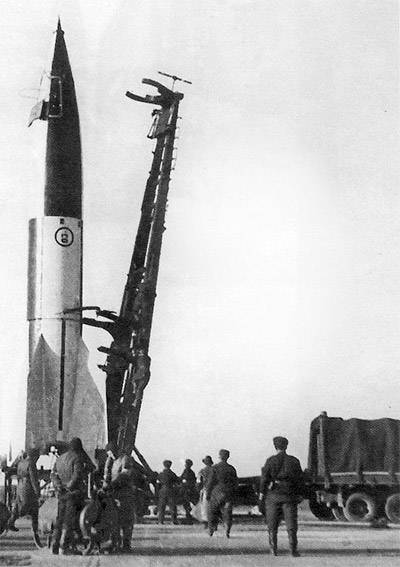
Product on the starting position. Photo Militaryrussia.ru
On the basis of German developments, a launch pad 8U23 was created with a supporting device for the rocket and a deflected cable mast. For transportation and installation on the table was proposed a special conveyor-lift based on a two-axle car trailer. Also, the means of the missile complex included transport and auxiliary machines for various purposes. Preparation of the rocket on the technical position took up to 3-4 h, the deployment of the complex before firing - up to 4 h.
New challenges
17 September 1948, the first launch of the P-1 rocket took place. During the launch, the control system failed, and the rocket deviated from the calculated trajectory. The product rose to an altitude of 1,1 km and soon fell into 12 km from the launch site. Soon there were several new attempts to launch, but in all cases there were problems, including those that led to fires. At this stage, the flaws in the design of three missiles were identified.
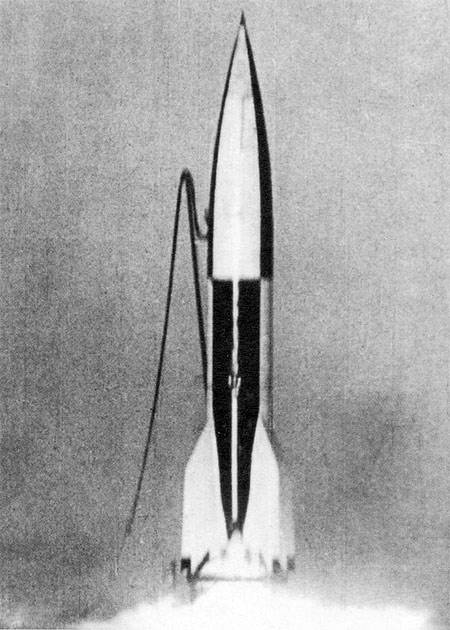
The rocket at the time of turning on the engine. Photo RKK Energy / energia.ru
October 10 held the first successful launch of an experienced P-1 at a distance of 288 km. The rocket deviated from the given direction on 5 km. The next day, the launch was again hampered by problems, but on October 13 a new flight took place. Then they organized another nine launches, and six of them went smoothly. The rest had to be canceled due to the identification of certain problems. The tests of the P-1 of the first series ended on November 5. By this time, managed to perform a series of four successful starts in a row. The maximum range of the missile reached 284 km, the minimum deviation from the target is 150 m.
The following year, 1949 organized static and dynamic missile tests in the existing configuration. Taking into account their results, as well as on the basis of the experience of flight design tests, it was decided to change the existing project to enhance certain characteristics.
The updated version of the P-1 / 8А11 rocket was distinguished by an improved guidance system built using only domestic components. Among other things, the radio signal correction system was replaced. There have also been numerous improvements in the design and equipment, taking into account the experience of previous flight tests.
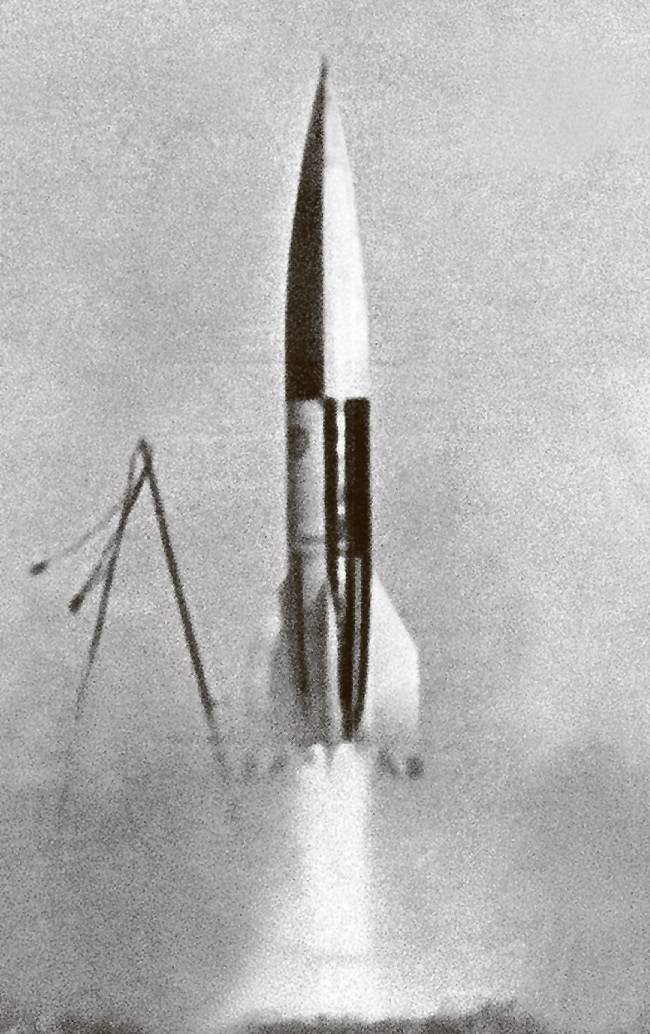
Instant after separation. Photo RKK Energy / energia.ru
In the same year 1949 produced two dozen experienced rockets of the updated design. Half of them were intended for sighting tests, and with the latter one should perform test launches. All the necessary work took several months, and state tests were completed only in the fall. From 20 17 missiles coped with the tasks and confirmed the calculated characteristics. The missile system based on the P-1 product was recommended for use.
Series and Service
25 November 1950 of the P-1 / 8А11 missile system was adopted. In the early summer of next year, an order was issued to start mass production. Initially, the missiles were to be produced within the framework of cooperation between the experimental production of the Scientific Research Institute-88 and Plant No. XXUMX (Dnepropetrovsk). In the future, a pilot plant of a scientific organization had to focus on other products and leave the production of the P-586. Serial rockets of the first batch hit the proving ground about a year after the start of production. By this time, it was decided that the R-1 would go into service with the special purpose missile brigades of the RVGK.
The task of nine new BON MWCs was to deploy missile complexes in positions and defeat enemy stationary objects of operational or strategic importance. It was assumed that the team will be able to carry out up to 32-36 launches per day. Each of its three divisions could send daily targets of up to 10-12 missiles. In peacetime, special purpose brigades regularly participated in exercises and used their weapons at the test sites.
Serial production of P-1 missiles and components of the missile complex continued until the 1955 year. Soon after this, the process of replacing the obsolete weapons with new models started. BON RVGK wrote off P-1 missiles and received more advanced P-2 instead. The latest “Victory” missiles, as far as is known, were launched at test sites in 1957. From the moment the tests began to the end of the operation, 79 rocket launches were conducted. Also took place almost 300 test engine starts. By the early sixties, the army had lost the last P-1 missiles and mastered the new missile systems.
***
The national program for the development of promising long-range ballistic missiles started with the study and assembly of trophy foreign samples. During inspections and tests, it was determined that such weapons are of interest and can be copied. However, it was not about direct copying, and to mass production, in the end, the rockets of the new design were brought, which had serious advantages over the basic designs of the German design.
The complex with a ballistic missile P-1 / 8А11 was the first model of its class, adopted in service in our country. Subsequently, new versions of the rocket were created with various differences and advantages. Then began the development of completely new missiles, based only partially on the existing one. However, this development of technology continued for a limited time. By the early sixties, the designers had to look for completely new ideas and solutions.
Rocket R-1 "Victory" was adopted by the Soviet army in 1950 year and remained in service until 1957-58 years. By modern standards, this weapon did not differ high performance. The “long-range missile” of the fifties in its basic characteristics corresponded to the current operational-tactical systems, however, in this form it made a significant contribution to the security of the country. In addition, it gave a start to all the main directions of development of domestic rocket armament "earth-to-earth", from operational-tactical to intercontinental systems.
On the materials of the sites:
http://mil.ru/
https://energia.ru/
http://russianspacesystems.ru/
http://kap-yar.ru/
http://spasecraftrocket.org/
http://buran.ru/
https://defendingrussia.ru/
https://modelist-konstruktor.com/
http://militaryrussia.ru/blog/topic-266.html
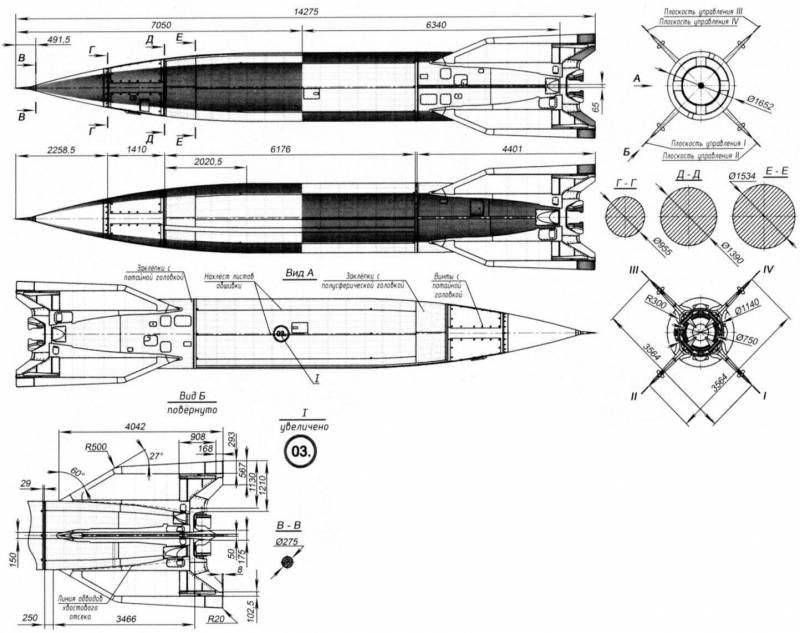
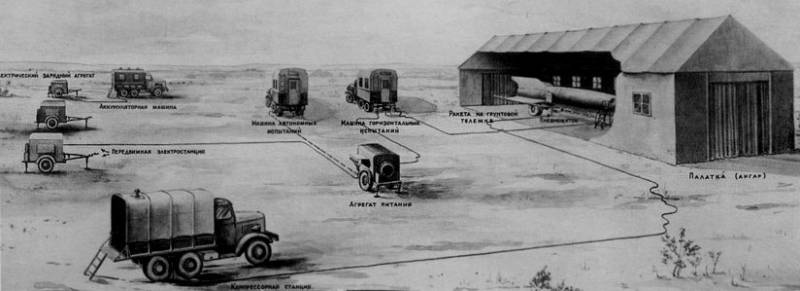
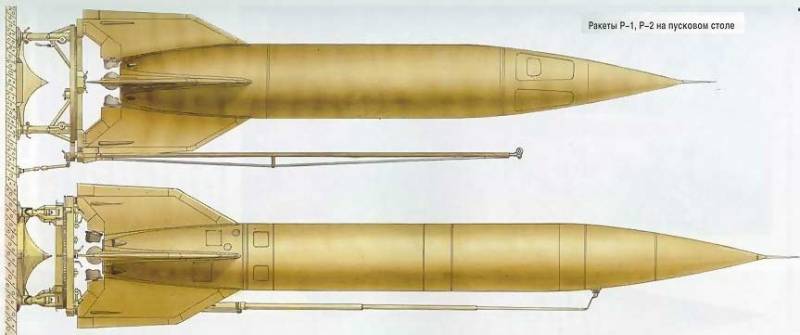
Information